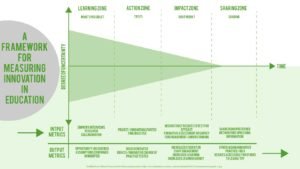When discussing innovation in education, I often hear, the stakes are high, higher than that of the “business world.” Failing fast means failing a learner and that’s a sticky proposition! However, we can’t test changes of practice or new ideas without innovating. Today, we are forced into preparing for a future that’s already surpassed the current educational model. How do we hedge our bets, minimize our risk but maximize our results? We need a framework for measuring innovation to know which innovations are working that should continue and which ones aren’t effective. Knowing that’s the need, I searched for one that will either work for education or one that can act as a launchpad for us. As I searched, I found a succinct model designed for the business world, so I spent time making modifications.

Think about breaking your new ideas/projects/innovative practices into zones. By breaking it up, innovation seems a bit more manageable and also has the possibility of helping your organization grow.
Get in the Zone
- Hedge your bets in The Learning Zone: This is where you are discovering and searching for new things to try with your staff or students. Begin with the end in mind. What are you trying to achieve? Do you understand your audience? Do empathy interviews and collaborate with your colleagues.
- The Action Zone is where you brainstorm and try your new idea or change of practice. You hedged your bets in the Learning Zone; now you are implementing your innovation!
- The Impact Zone helps you understand whether or not the innovation worked. Gathering understanding can be in the form of a discussion with staff or students, a survey, or a formative assessment. Did the learners feel engaged in the activity and did they accomplish the desired outcome or learning targets?
- The Sharing Zone propels innovation within your organization. It is important to share what’s working with others, so while they are in the Learning Zone, they can use your experience to grow and innovate.
Breaking work into smaller parts/zones makes it feel manageable and knowing that there’s measurement involved, the odds that learners are “failed” decreases. Do you have any ideas for improving the framework? If you do, mention them in the comments!

